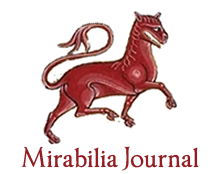The influence of Abū Ṭālib al-Makkī’s (d. 386 H./996 C.e.) Qūt al-qulūb and al-Sulamī’s (d. 412 H./1021 C.e.) Ṭabaqāt al-ṣūfiyya in the development of sufi literature
Virginia VÁZQUEZ HERNÁNDEZ
Original title: La influencia de Qūt al-qulūb de Abū Ṭālib al-Makkī (m. 386 H. /996 e.C.) y Ṭabaqāt al-ṣūfiyya de al-Sulamī (m. 412 H. /1021 e.C.) en el desarrollo de la literatura sufí
Published in
Keywords: Humanidades Digitales, Influencia, Literatura sufí, Qūt al-qulūb, Ṭabaqāt al-ṣūfiyya.
Qūt al-qulūb de Abū Ṭālib al-Makkī (m. 386 H./996 e.C.) y Ṭabaqāt al-ṣūfiyya de al-Sulamī (m. 412 H./1021 e.C) son dos obras sufíes que se compusieron en el periodo de transición del ascetismo al misticismo. Tanto sus doctrinas como el modo en que se redactaron influyeron en autores y obras posteriores. Basándome en un programa desarrollado por el proyecto KITAB, analizaré el papel que jugaron ambas obras en el desarrollo de esta literatura en el Oriente y el Occidente islámico.
The introduction of Humanism in the Iberian Peninsula
Julia BUTIÑÁ JIMÉNEZ
Original title: La introducción del Humanismo en la Península Ibérica
Published in Medieval and Early Modern Iberian Peninsula Cultural History
Keywords: Catalan Literature, Cultural change of fifteenth century, Humanism, Iberian Peninsula.
Summary statement of the reception of Humanist movement in the Iberian Peninsula, which is introduced by the Crown of Aragon. Apart from a few preconceptions about their appearance, characterization, proccess, and current critical situation, the theme focuses on the main production of Humanistic character in Catalan, highlighting Bernat Metge by its prominence and be receiver the very first impact.
The language in the medieval scholasticism
Ivanaldo SANTOS
Original title: A linguagem na escolástica medieval
Published in Monastic and Scholastic Philosophy in the Middle Ages
Keywords: Language, Medieval, Problem, Scholasticism, Thomas Aquinas.
This article aims introducing the problem of the language in the medieval scholasticism, specifically in the work by Tomás de Aquino, thinker of greater notoriety in the scholasticism. In order to achieve this goal this article was divided in two parts: 1) The medieval scholasticism; 2) The language in the thought of Tomás de Aquino. Finally, it is confirmed that is necessary perceive that the medieval scholasticism provided relevant discussions about themes that centuries later, guided the modernity, for example, the method, the logic and the language.
The medieval feminine writing: mystic, passion and transgression
Maria Simone Marinho NOGUEIRA
Original title: A escrita feminina medieval: mística, paixão e transgressão
Published in Mulier aut Femina. Idealism or reality of women in the Middle Ages
Keywords: Feminine, Mystic, Passion, Transgression., Writing.
In this paper, we try to present some of the medieval feminine mystic, concentrating mainly on the thought of Marguerite Porete. Among other things, our intention is to show that the studied women had a strong literary culture, and also that their works oscilate between transgression and passion.
The medieval music: between sound number science and beautiful art
Celina A. LÉRTORA MENDOZA
Original title: La música medieval: entre ciencia del número sonoro y arte bella
Published in The Medieval Aesthetics
Keywords: Ethics of Music, Harmony, Medieval Music, Melody, Science of Sound.
It is almost a topic both in the history of music and in the history of acoustic science, that in antiquity music was understood especially as the science of sound number, forming part of the quadrivium, and establishing a connection we would say natural between music understood as harmony and rhythm and mathematics and astronomy, discarding the concrete aspect of musical interpretation and its effects. It is also a topic to say that in the Renaissance period there are two new phenomena: the physical (and not only mathematical) consideration of the “sound number”, with the study of vibrations or acoustics, on the one hand. On the other, the incorporation of music into the world of fine arts (that is, considering its sensitive and affective aspect, as “capturing the beautiful”), which would not have happened before, neither in Antiquity nor in the Middle Ages. Without discussing the point related to Antiquity, given that the documentation on this matter is very scarce and susceptible of diverse interpretations that cannot be verified, and focusing on the Middle Ages, an attempt will be made to provide arguments in favor of the following theses. That in the Middle Ages, especially since the 12th century, a process of approach between the consideration of "the mathematical" and the "beautiful" begins, while two concepts of beauty are analyzed and discussed: as splendor of order and as splendor of form. In this way the splendor formae would be a way from which to privilege the musical beauty of the melody. That in this process, long, complex and with many inflection points, two lines can be highlighted: the monastic religious song and the court music (possibly the upper troubadour). In both cases a greater appreciation of the melody gradually appears, seeking to produce a feeling of beauty to bring the soul (that is, the spirit) closer to the superior (religious or the beautiful human) from the materiality of sound.
The medieval ruin in Caspar David Friedrich’s landscapes
Mar LLOPIS ORIVE
Original title: La ruina medieval en los paisajes de Caspar David Friedrich
Published in
Keywords: Friedrich, Gothic Revival, Gothic architecture, Landscape Painting, Medieval ruin, Middle Ages, Romanticism.
Romanticism brings along the revaluation of medieval art, especially of Gothic architecture, until then denied and despised. From this will echo romantic paintings, in which the representation of medieval ruins will become commonplace. Friedrich (1774-1840) is the most paradigmatic artist of this particular context, and therefore, our study will focus on his work.
The monastery and the social function of religious architecture: the Cantiga 45 of the Cantigas de Santa Maria by king Alfonso X (13th century)
Bárbara DANTAS
Original title: O mosteiro e a função social da arquitetura religiosa: a Cantiga 45 das Cantigas de Santa Maria do rei Afonso X (século XIII)
Published in
Keywords: Cantigas de Santa Maria, Medieval architecture, Middle Ages, Monastery.
D. Afonso wanted his obra maestra, the Cantigas de Santa Maria, to encompass everything that man sees and feels. And there is nothing more seen and felt than Architecture. Especially for us Religious Architecture. In Cantiga 45, the wise king presents us with a miracle report in which a knight, very affectionate to bad attitudes, wished to repair his errors and build a monastery dedicated to the Virgin Mary. His monastery would have all the rooms and spaces necessary for the monastic life.
The mouth and the sweetness. Some remarks on taste metaphors in Hildegard of Bingen’s book Scivias
María José ORTÚZAR ESCUDERO
Original title: La boca y lo dulce. Algunas reflexiones sobre de la tropología del gusto en el libro Scivias de Hildegarda de Bingen
Published in Senses and sensibilities in classical and medieval worlds
Keywords: Christian authors, Hildegard of Bingen, Sense metaphors, Taste, gupulochyvy481.
Several studies on the visions of Hildegard of Bingen (1098-1179) emphasize their "otherness" with respect to the sensible world and the bodily experience. For some years, though, also the importance of the sensory language in religious texts has been highlighted. This paper explores the sense metaphors, particularly the taste metaphors, in Hildegard's first visionary work, Scivias. In this writing, she associates the taste of sweetness as well as food itself mainly with two subjects: the sin and Christ. This use of taste metaphors has biblical and patristic backgrounds. 12th Century authors like the Cistercian Bernhard of Clairvaux and the Benedictines Honorius Augustodunensis and Rupert of Deutz use as well taste metaphors to illustrate the fall into sin and the return to God through Christ. Thus, the sense of taste seems to offer them a basis for understanding human condition. Furthermore, the use of taste-metaphoric reveals the possibility of experience the divine by means of the sensibility of the human body.
The murals of Siena’s Palazzo Pubblico. Paintings for a city at war
Jesús CANTERA MONTENEGRO, Clara Mª CASTREJÓN VELLÉ
Original title: Los frescos del Palazzo Pubblico de Siena. Pinturas para una ciudad en guerra
Published in
Keywords: Ambrogio Lorenzetti, Good and Bad Government, Maestà, Medieval Italian frescos, Simone Martini.
Study of the Siena’s palace paintings as an example of a secular public interior in the Middle Ages and the social and political circumstances that influenced them in their iconography and symbolism, taking a special attention to Ambrogio Lorenzetti’s Good and Bad Government and Simone Martini’s Maestà.
The musical esoterism of Francesco Zorzi (1466-1540) in the work De harmonia mundi totius (1525)
André GABY
Original title: O esoterismo musical de Francesco Zorzi (1466-1540) na obra De harmonia mundi totius (1525)
Published in Music in Antiquity, Middle Ages & Renaissance
Keywords: Christian Kabbalah, Esoterism, Philosophy of music, Pythagoreanism, Renaissance.
The humanism and the musical renaissance derived from it are both the result of Italian thinkers contact with the Neoplatonic and Hermes Trimegistus works – coming from Byzantium thanks to the fall of Constantinople in 1453 – and with Kabbalistic works brought by Jews definitively expelled from Spain. in 1492. Among so many names in Italian humanist thought, stands out in Venice the Franciscan friar Francesco Zorzi (Giorgi). He learned the Hebrew language and the teachings of Kabbalah, dedicating his intellectual efforts to the continuation of the synthesis work of ideas on spiritual elevation (Platonic, Aristotelian, Neoplatonic, Hermetic, Jewish, or Christian) initiated by Marsilio Ficino and Pico della Mirandola. Zorzi believed that Kabbalah could prove the truths of the faith of Christianity present in the Bible, that is, the numbers generated by the letters of the Hebrew alphabet would be related to the Pythagorean “Harmony of the Spheres” conception, and the truths of the cosmos reality would be described in the scriptures enterlines of Judeo-Christian religious tradition. Our work consists of presenting to the Portuguese language community the esoteric-kabbalist musical conception present in the work Harmonia mundi totius by Francesco Zorzi, together with some extract’s translation into Portuguese.






















































































